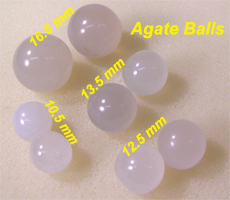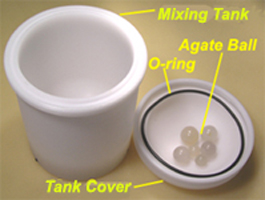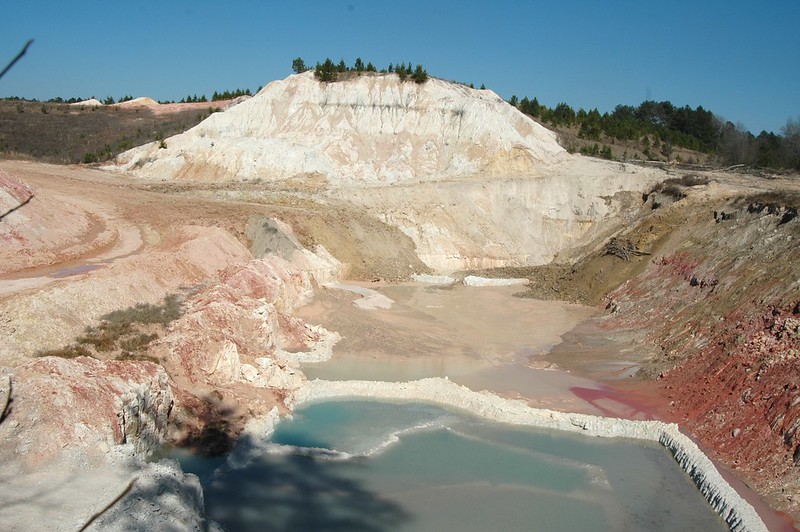jamesp
Cave Dweller 
Member since October 2012
Posts: 36,612
|
Post by jamesp on Oct 20, 2017 8:05:47 GMT -5
This one about 35 pounds. Common. Pried out of blue/white clay with 5 foot pry bar. Silicified innards probably a boring off white hard agate like material, maybe, probably. Never know. Root on right, sun grabbing side left. Dark face is where pithy poorly silicified covering fell away and looks solidly silicified.  Top is sun grabbing face. Bottom is root. Left dark area is the silicified blob within. The rest is a pithy covering showing original shape that would normally erode away and leave behind the silicified blob within.  Sun grabbing side with corallites intact. This too is a pithy layer that the elements would eventually remove. Blue color is from the blue/gray clay it was encased in. Clay protected it from the elements. Probably never experienced freezing conditions or impact damage of any geological form.  A bit deceptive photo, this is the pointed root end looking straight at you. Silicified blob at lower right side. 2 inch area of pith freshly broken off when prying center/right  |
|
jamesp
Cave Dweller 
Member since October 2012
Posts: 36,612
|
Post by jamesp on Oct 20, 2017 8:16:52 GMT -5
Agate balls for a ball mill. 1/2" to 2.5". Most made in China out of poorly colored Brazilian agate. Expensive to manufacture. Materials expensive too. The coral would probably serve them better than Brazilian agate as it is both hard but probably more chip resistant. Both Brazilian agate and these type of coral formations would pass quality standards as they are with few fractures. However coral has lots of microscopic pits which may cause them to be unfit for purity standards. Unless the balls were used on the same material repetitively. I believe aluminum oxide is broken down using an agate ball mill. Coral occurs in large enough pieces for manufacturing such balls. I really need to send some coral to a ball mill manufacturer to try; there could be a market. Sure would like to see their sphere grinding machine. .jpg)  Small desk top ball mill barrel. They are driven just like a rotary tumbler. Often the barrels are made of agate. Some use solid aluminum oxide balls. This type small ball mill used for making powder out of solids in lab environment.  |
|
|
|
Post by captbob on Oct 20, 2017 8:51:57 GMT -5
I like it. It's agatized coral, so of course I like it!
Question - what makes the clay blue?
|
|
|
|
Post by MrMike on Oct 20, 2017 18:52:32 GMT -5
I like it. It's agatized coral, so of course I like it! Question - what makes the clay blue? It’s sad?  ? |
|
Deleted
Deleted Member
Member since January 1970
Posts: 0
|
Post by Deleted on Oct 20, 2017 18:57:15 GMT -5
I like it. It's agatized coral, so of course I like it! Question - what makes the clay blue? I'm simply guessing, but it's a path to research. There is a clay called "gley" and it's blue'ish. |
|
|
|
Post by fernwood on Oct 20, 2017 19:38:05 GMT -5
I would say the clay, since jamesp said this as a caption for one of the above photos "Blue color is from the blue/gray clay it was encased in. Clay protected it from the elements. Probably never experienced freezing conditions or impact damage of any geological form. I am lovin' these corals/wood fossils. Also, the blue clay color. |
|
Deleted
Deleted Member
Member since January 1970
Posts: 0
|
Post by Deleted on Oct 20, 2017 20:29:30 GMT -5
Hi Ms Fern
The query was "what makes the clay blue". So your answer is kinda the question not the answer.
|
|
jamesp
Cave Dweller 
Member since October 2012
Posts: 36,612
|
Post by jamesp on Oct 21, 2017 0:55:17 GMT -5
fernwood @shotgunner MrMike captbobNot sure what makes clay blue. But if you do find clay exposed in the river bank you will likely find colorful coral. Different colored clays = different colored corals. And clay can vary several shades in a few feet. Coral found in sand is almost always off-white. Most clay deposits are in middle Georgia, from weathered mountains in North Georgia. Some of the northerly clay travelled down river channels to sand country lowlands in S Georgia/N Florida and coated some of the ancient coral beds. Sand inert silica, clay has all the minerals and chemicals making it many colors. Clay is complex. A few colors of clay in middle Georgia at a kaolin clay mine:  Pretty sure aluminum compounds makes kaolin clay white. 
|
|
jamesp
Cave Dweller 
Member since October 2012
Posts: 36,612
|
Post by jamesp on Oct 21, 2017 1:04:28 GMT -5
Sawing the big one. To big to close the saw cover  ACME saw oil deflection device  |
|
|
|
Post by fernwood on Oct 21, 2017 9:18:48 GMT -5
At my old place there were a variety of clay colors. There, the color was dependant on the types of surrounding minerals in the soil. Decomposition of surrounding organic matter, such as trees/leaves over many years, also came into play.
I had some striated yellow to deep orange areas, some bluish gray and some tan.
|
|
jamesp
Cave Dweller 
Member since October 2012
Posts: 36,612
|
Post by jamesp on Oct 21, 2017 10:19:11 GMT -5
At my old place there were a variety of clay colors. There, the color was dependant on the types of surrounding minerals in the soil. Decomposition of surrounding organic matter, such as trees/leaves over many years, also came into play. I had some striated yellow to deep orange areas, some bluish gray and some tan. Lots of sand,rocks and quartz. But clay is often the minerals and chemical compounds. Usually with color. You mentioned organic matter. If digging in the river out in the middle say at low water in a pool the organic matter is apparently black and often mixed with clay or deposited with clay particles. The water engineers would say clay and organics precipitated out of murky water and settled in pools. Next question to ask is how long has that muck been settled on the bottom. If one were to dig deep they may find clay and organic matter from 1000's and perhaps 100,000 years or longer. Well you can dig down on about any coral bearing river and find the ancient blue colored coral and often associated with blue clay. My guess to the answer to captbob's question is organic matter. Not aerobic clay exposed to air but totally anaerobic non oxygen bearing clay. Arrowheads made of coral found in the muck are often stained blue grey. Hah, on another clay rant. please forgive. Because of Georgia's fine clay deposits Georgia Tech developed the School of Ceramic Engineering. We are the silicon valley of clay. Clay barons instead of oil barons and land barons go figure. Georgia Tech would probably have liked to analyze your clay at your old place. |
|
Deleted
Deleted Member
Member since January 1970
Posts: 0
|
Post by Deleted on Oct 21, 2017 10:44:27 GMT -5
^^^love that
We need a "love that" button.
|
|
Deleted
Deleted Member
Member since January 1970
Posts: 0
|
Post by Deleted on Oct 21, 2017 11:03:31 GMT -5
jamespYou gonna mount that on a base as is? Seems logical it has awesome shape
|
|
jamesp
Cave Dweller 
Member since October 2012
Posts: 36,612
|
Post by jamesp on Oct 21, 2017 11:23:21 GMT -5
These guys found some monsters from the last weekend.  |
|
jamesp
Cave Dweller 
Member since October 2012
Posts: 36,612
|
Post by jamesp on Oct 21, 2017 11:29:09 GMT -5
jamespYou gonna mount that on a base as is? Seems logical it has awesome shape It will get put in the pile of the 'mountable' specimens. But that was the motive because of the shape. If it were dead white it would be a much more desirable accessory for interior display. Hard to get them white with chemicals. The ones from Florida are often blinding white. It was half pith and half solid silicified at that cut anyway. |
|
|
|
Post by captbob on Oct 21, 2017 11:55:10 GMT -5
These guys found some monsters from the last weekend.  What guys? Is there more to this or a video or ...? So my theory of the blue clay being from an ancient Smurf burial ground isn't the answer? |
|
jamesp
Cave Dweller 
Member since October 2012
Posts: 36,612
|
Post by jamesp on Oct 21, 2017 11:58:31 GMT -5
These guys found some monsters from the last weekend.  What guys? Is there more to this or a video or ...? So my theory of the blue clay being from an ancient Smurf burial ground isn't the answer? They may not want to be identified so I did not post there name. Just their loot. No proof of the Smurf theory.... |
|





.jpg)






 ?
?













